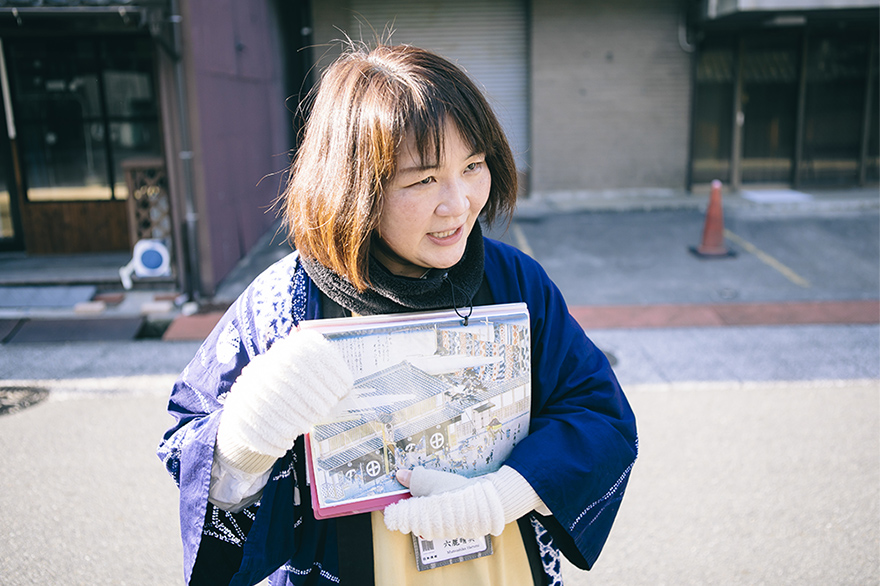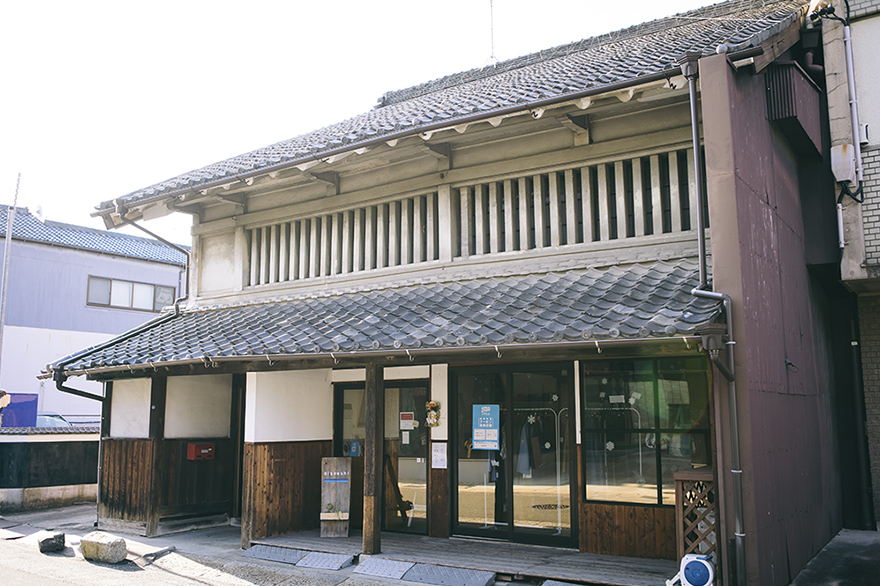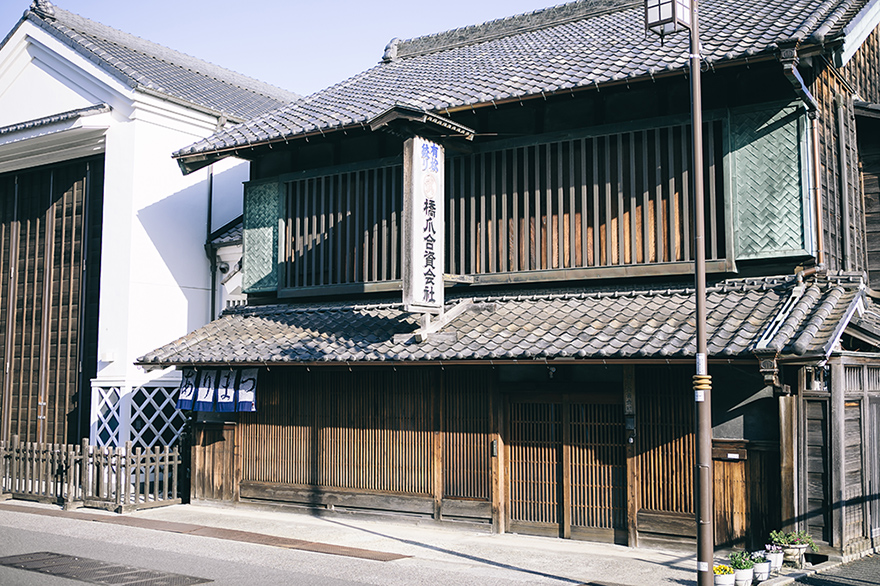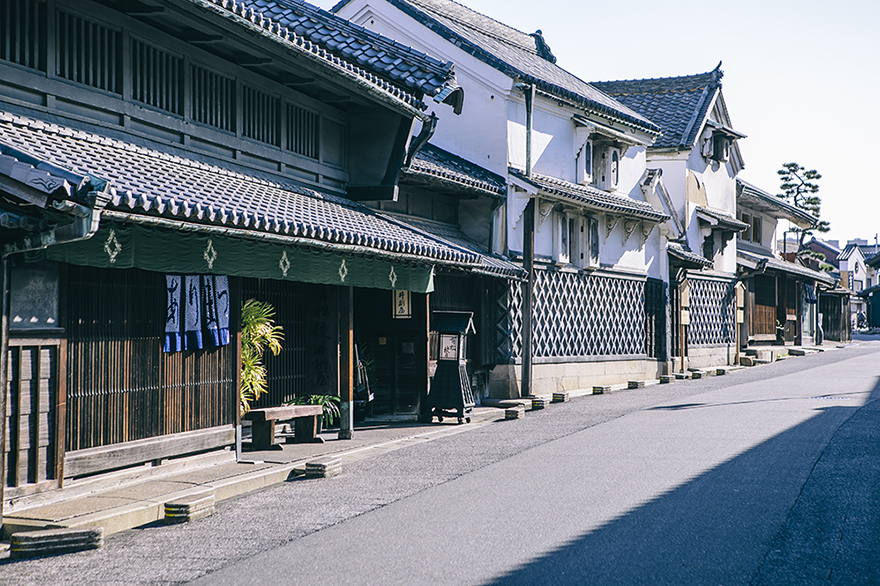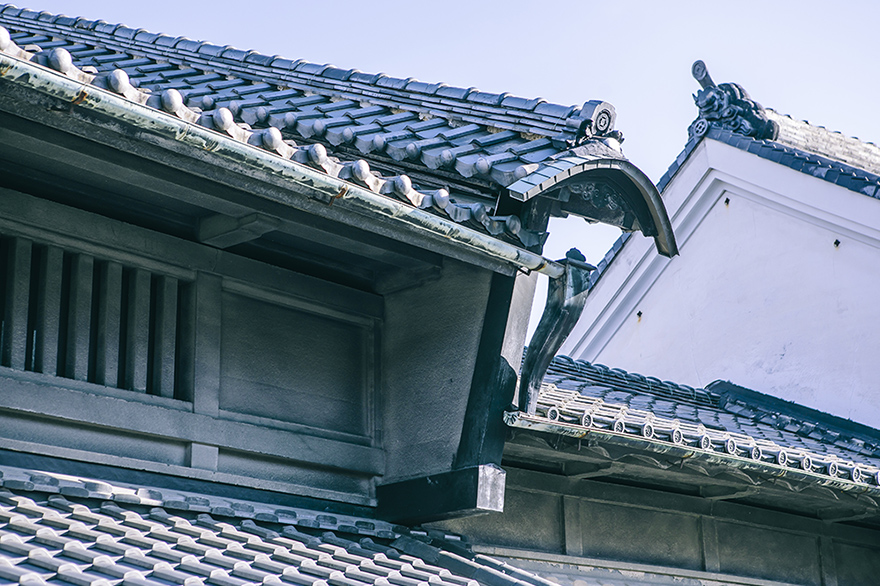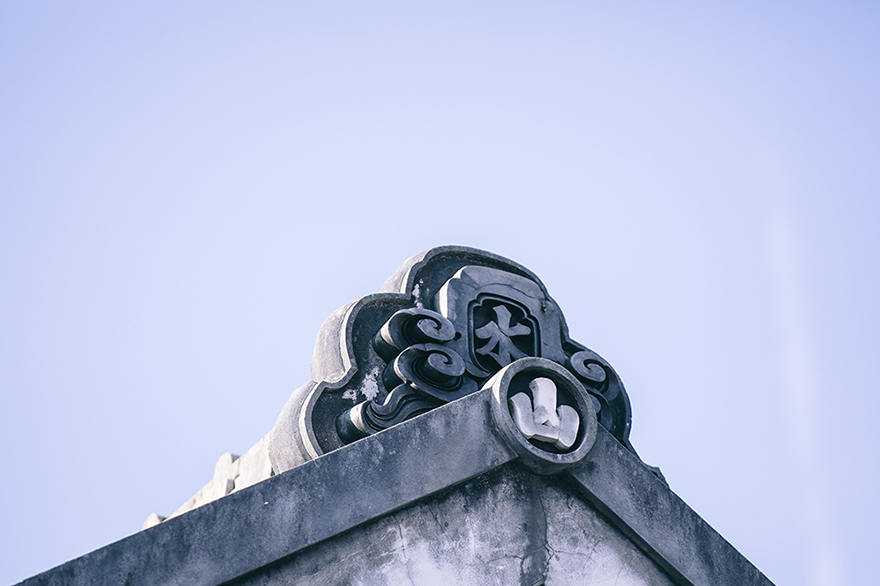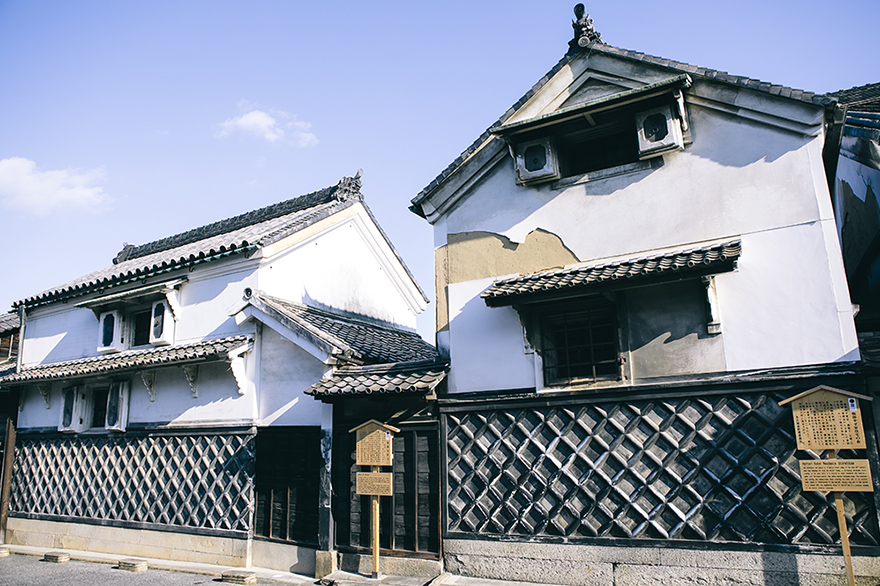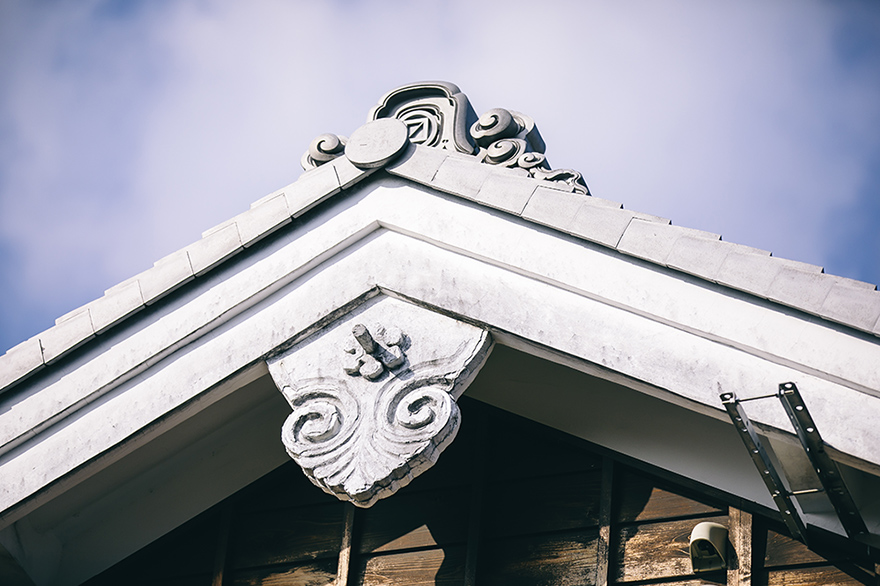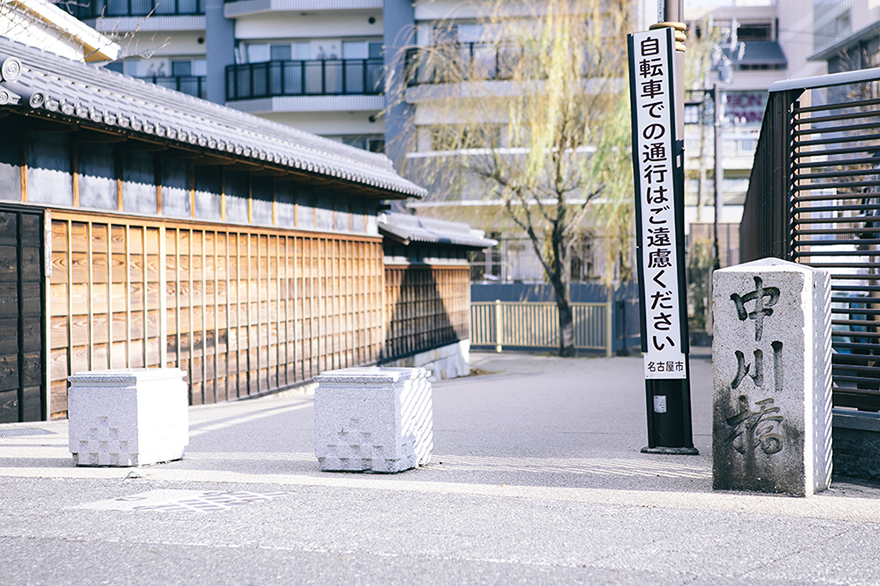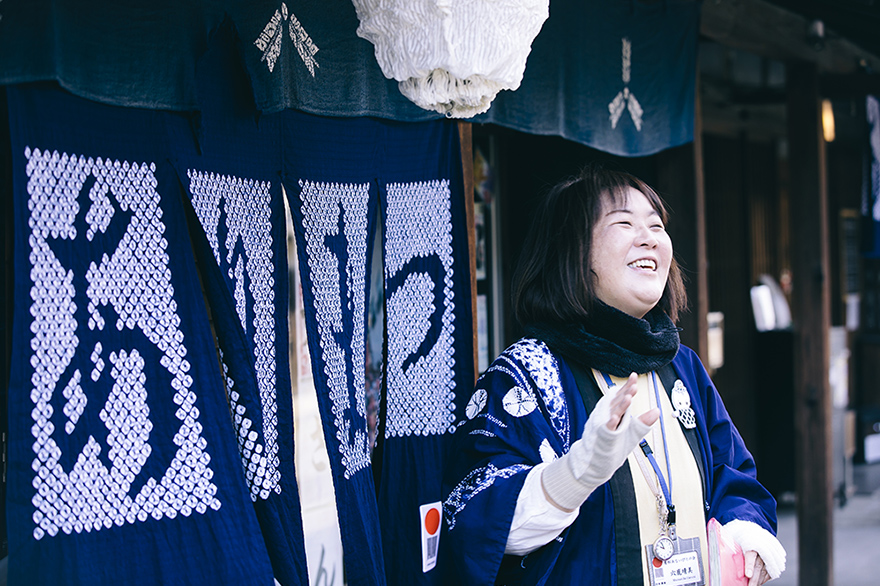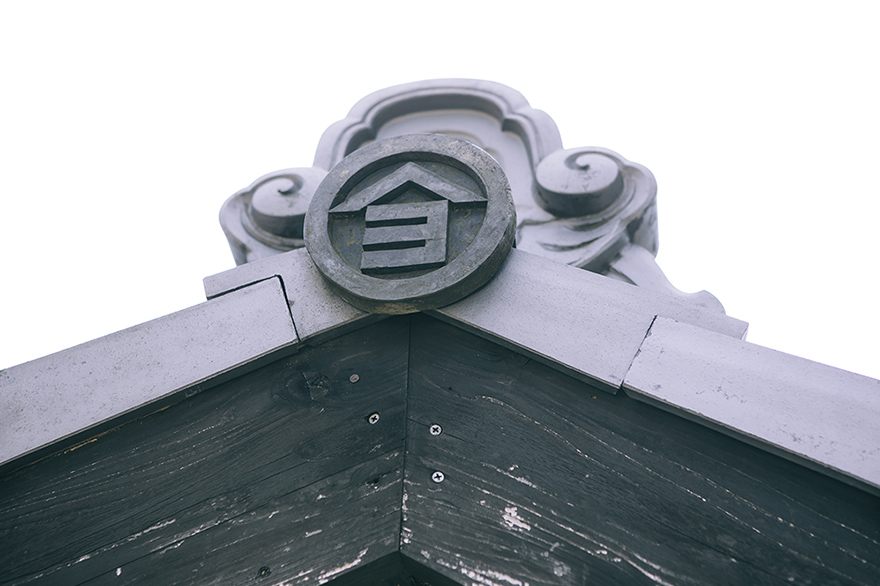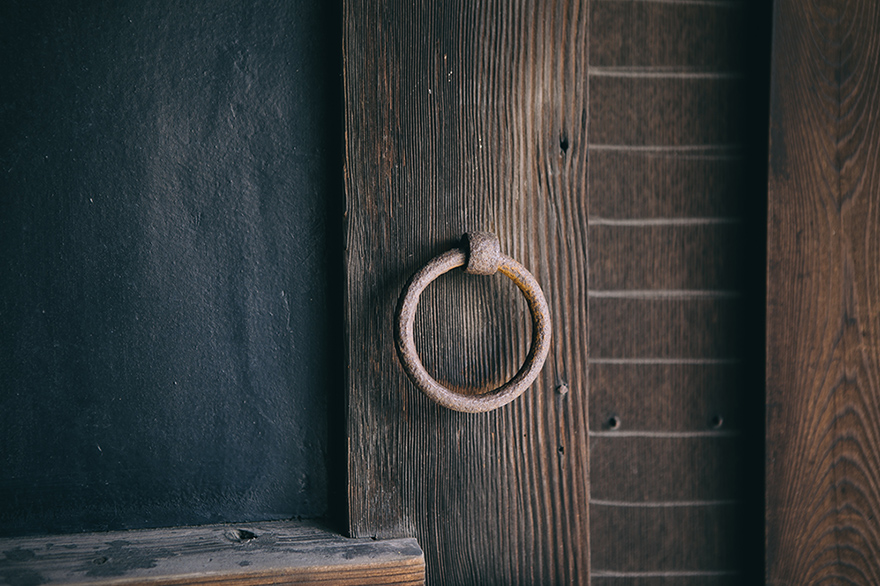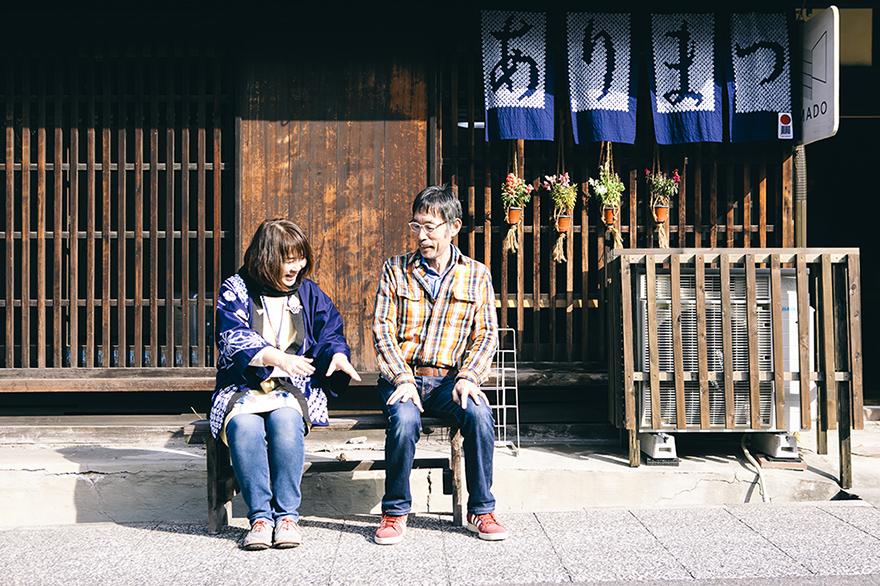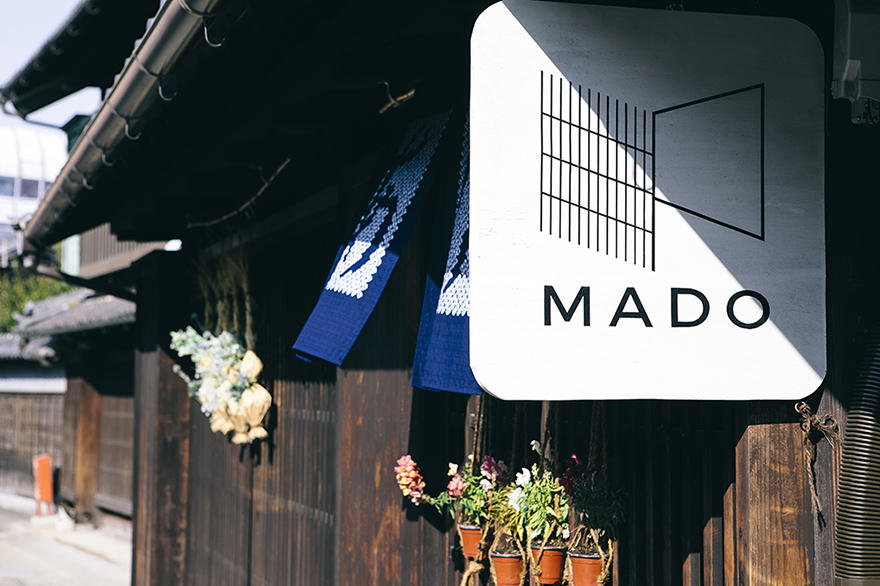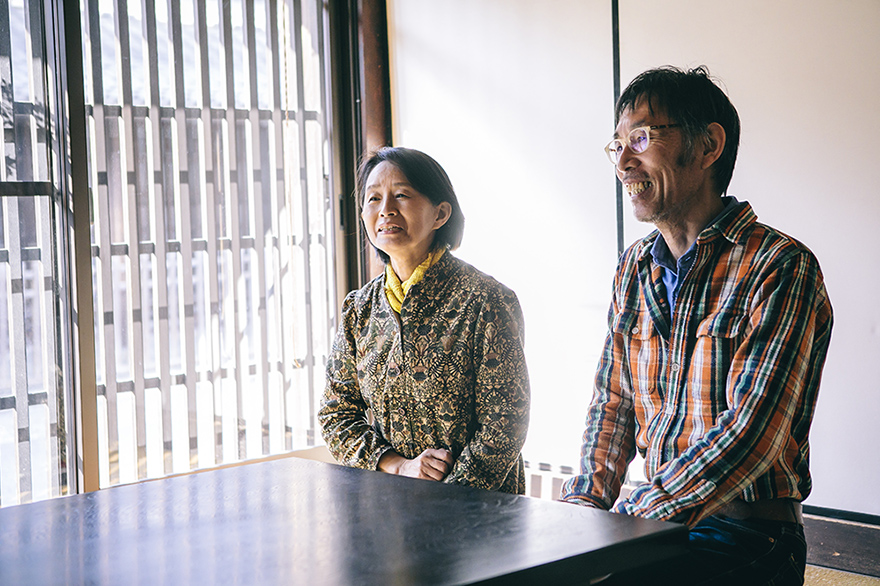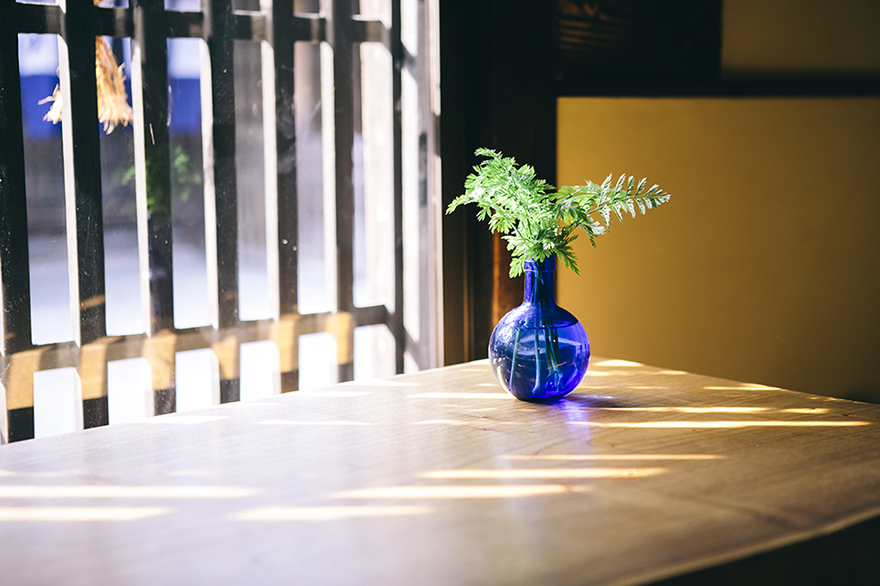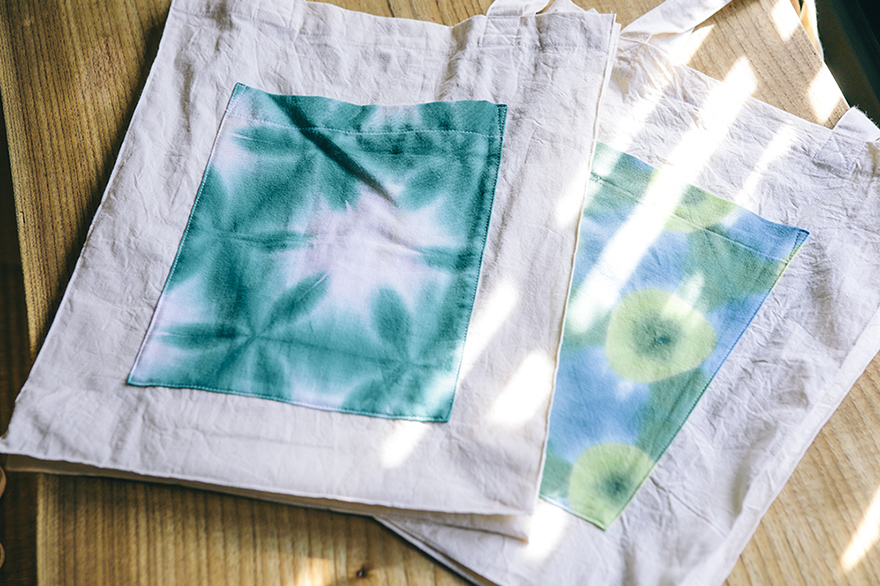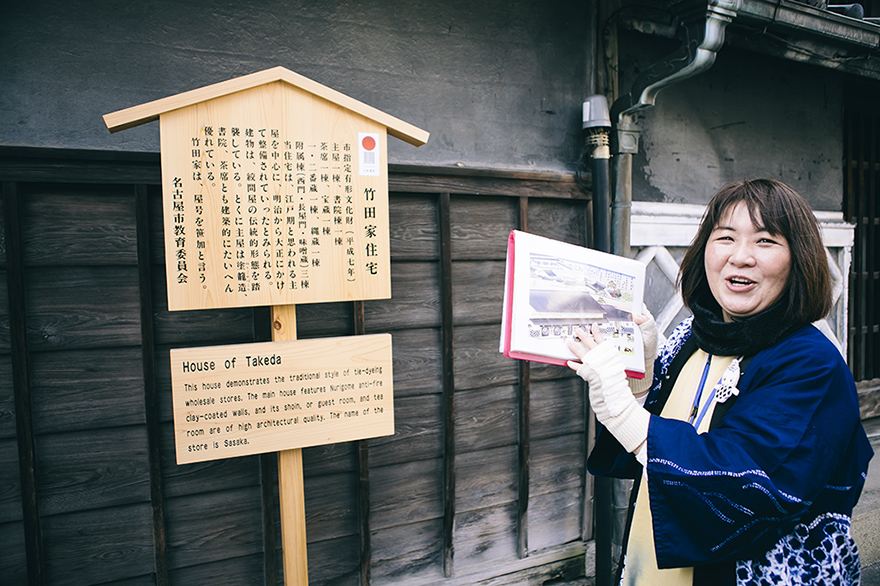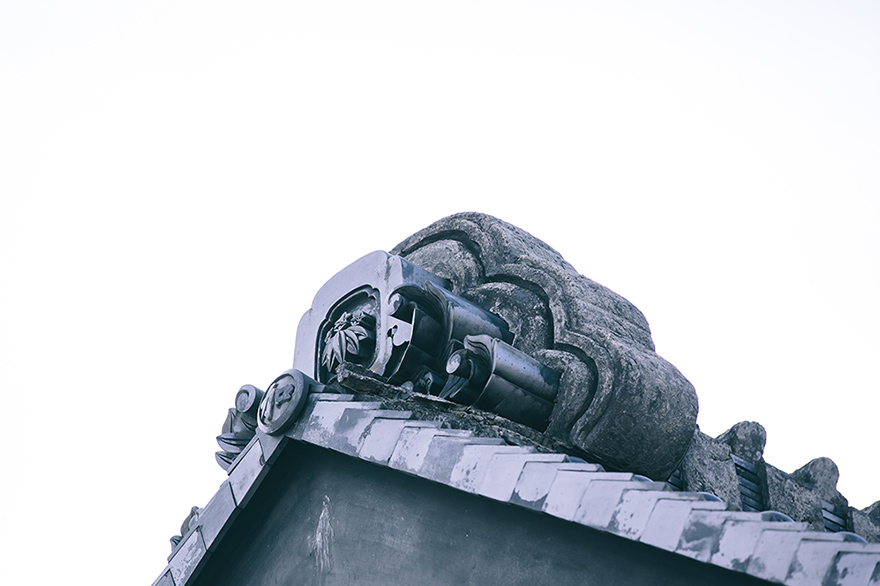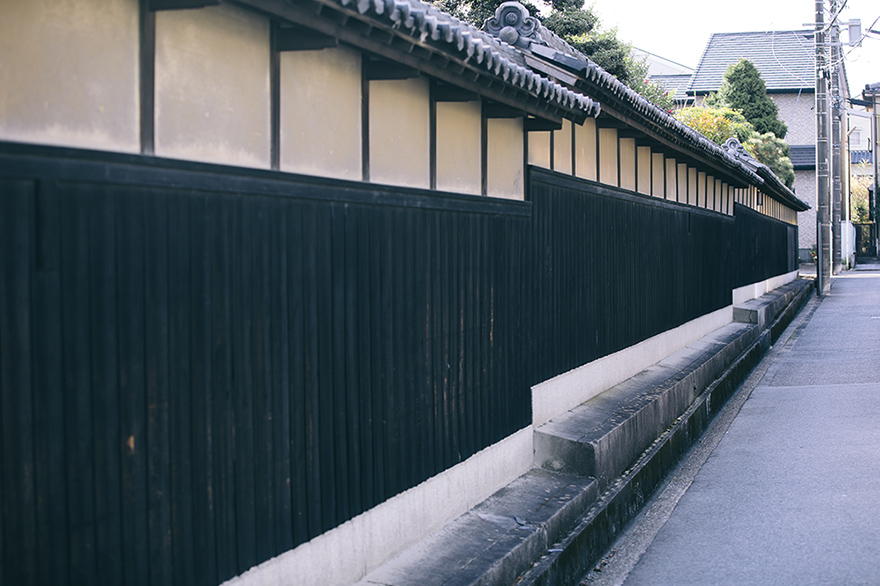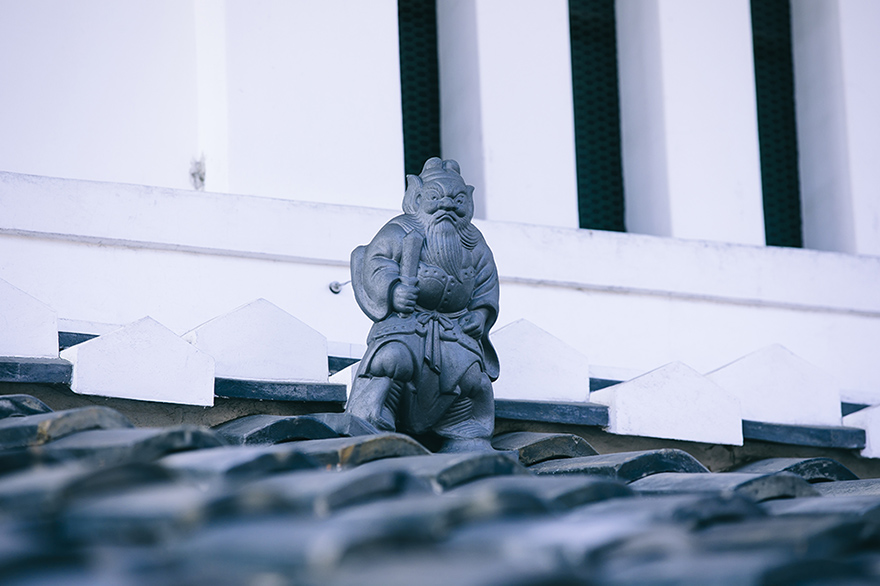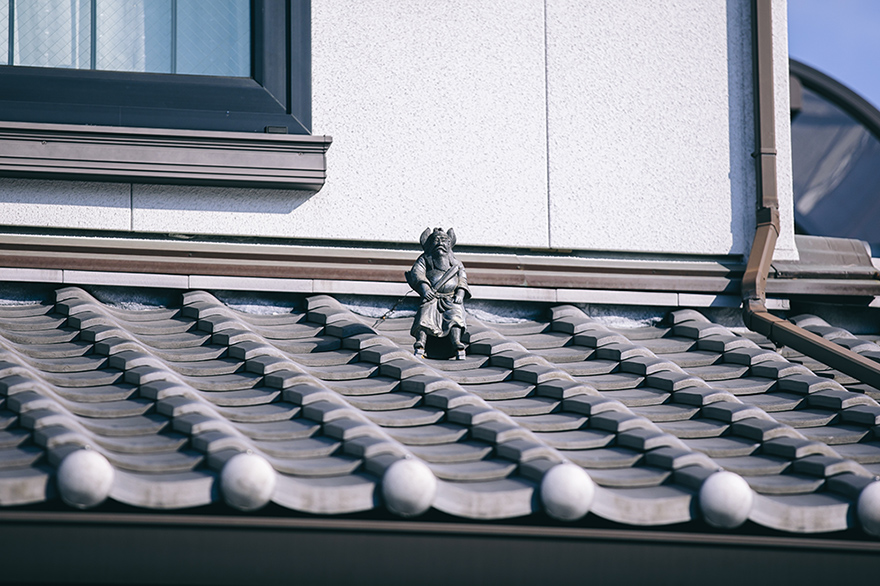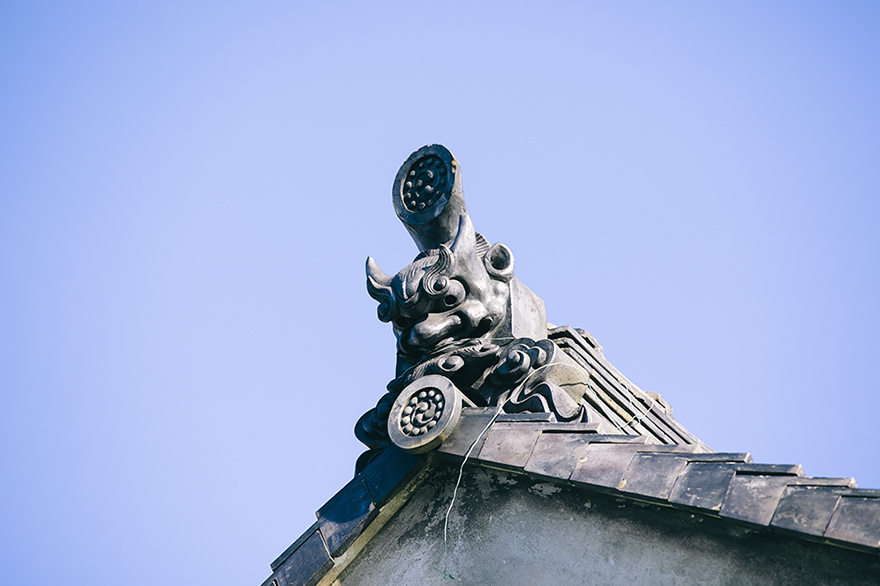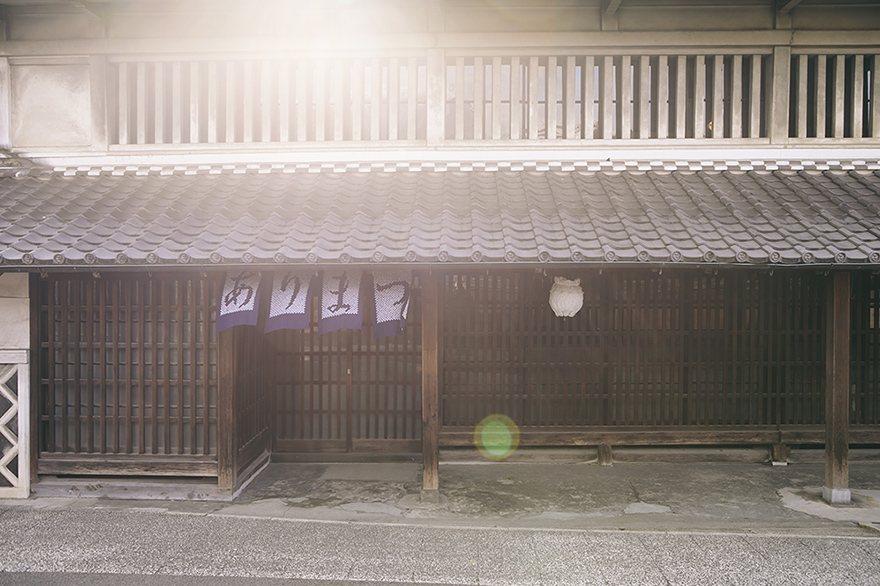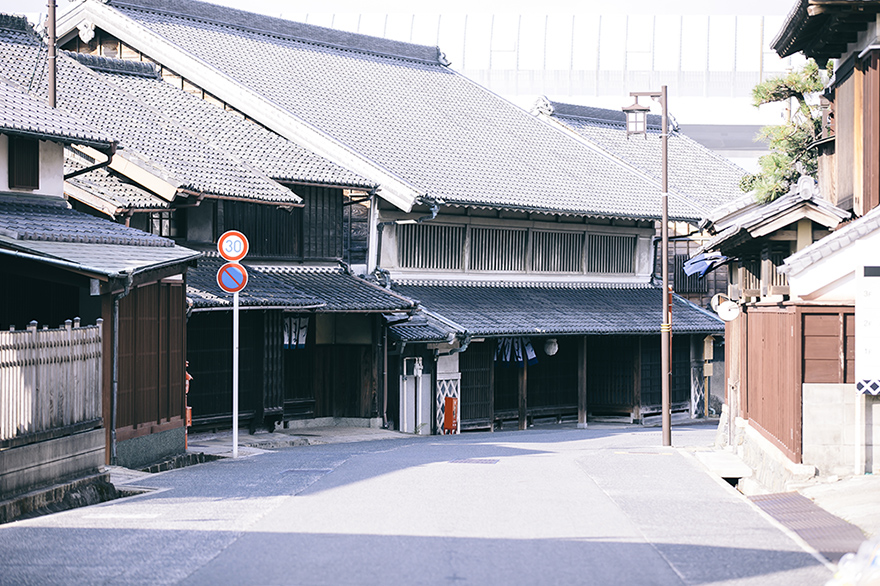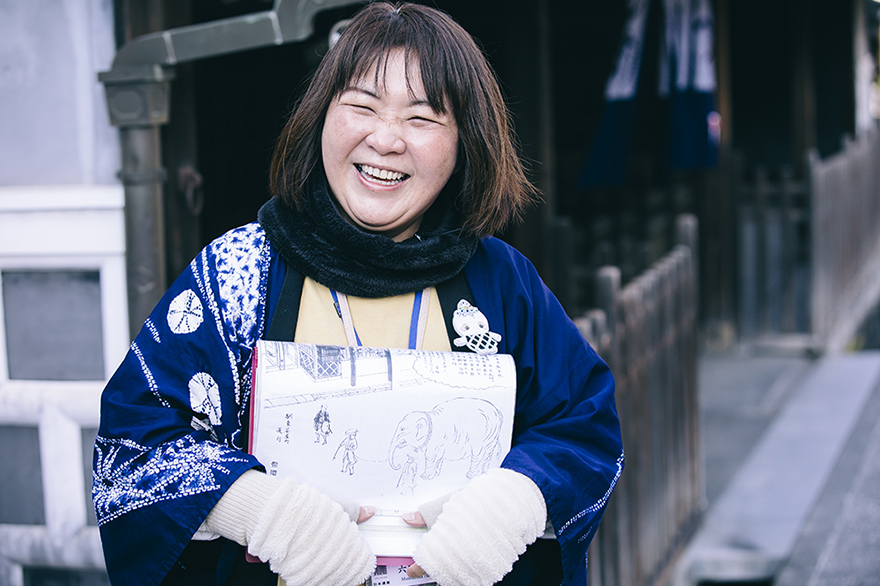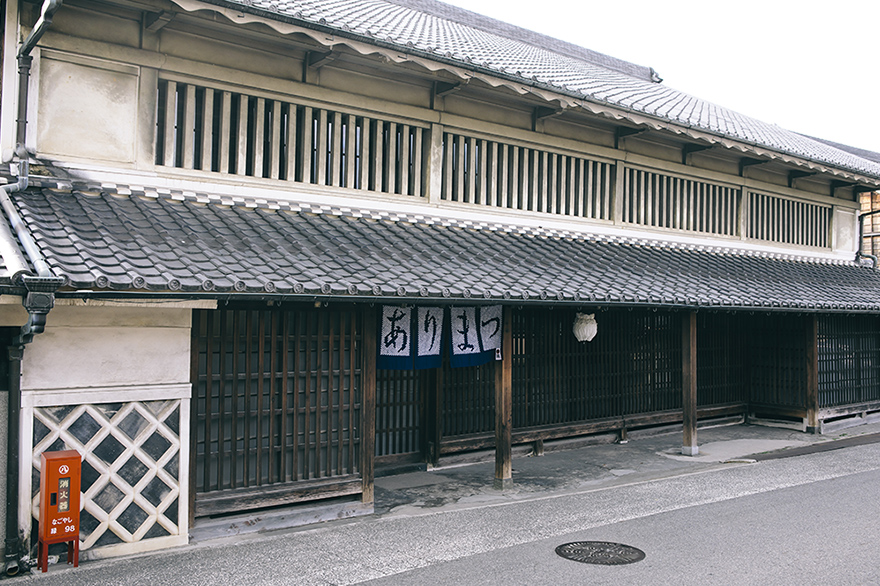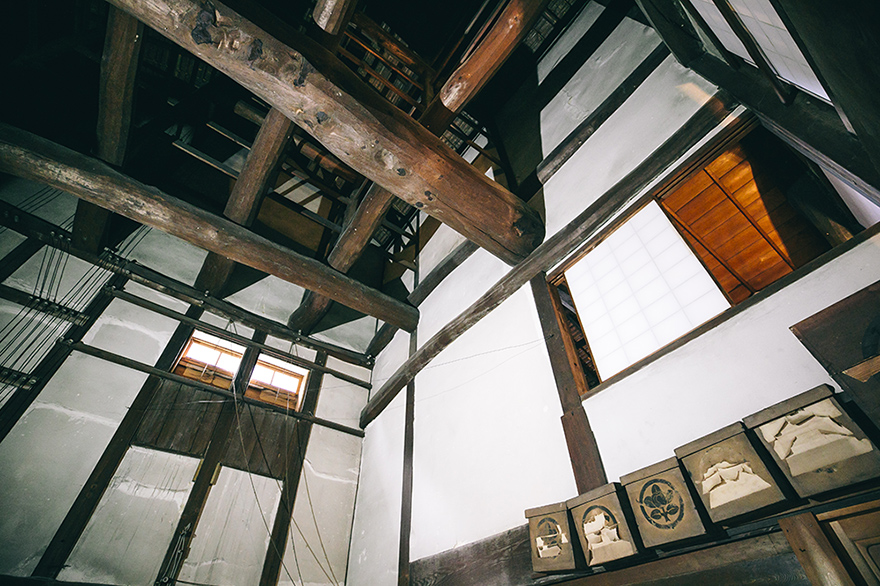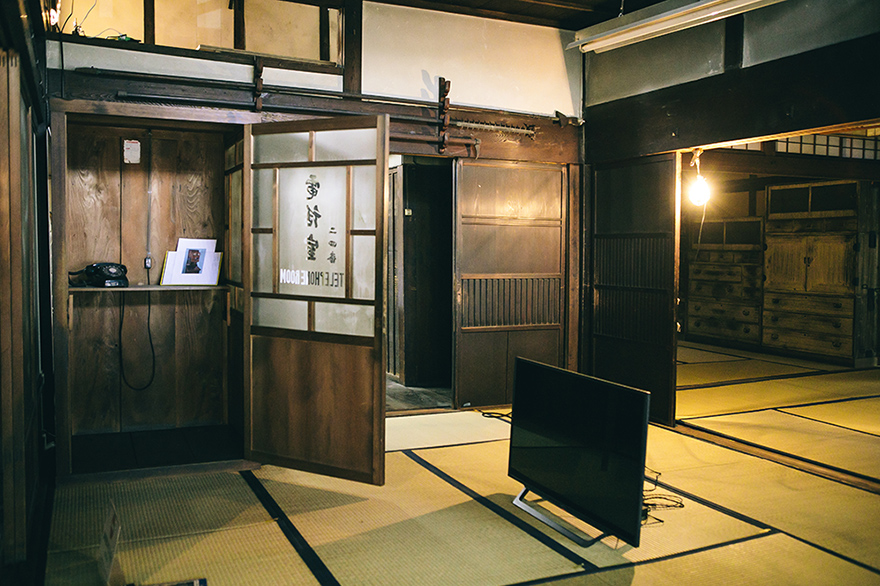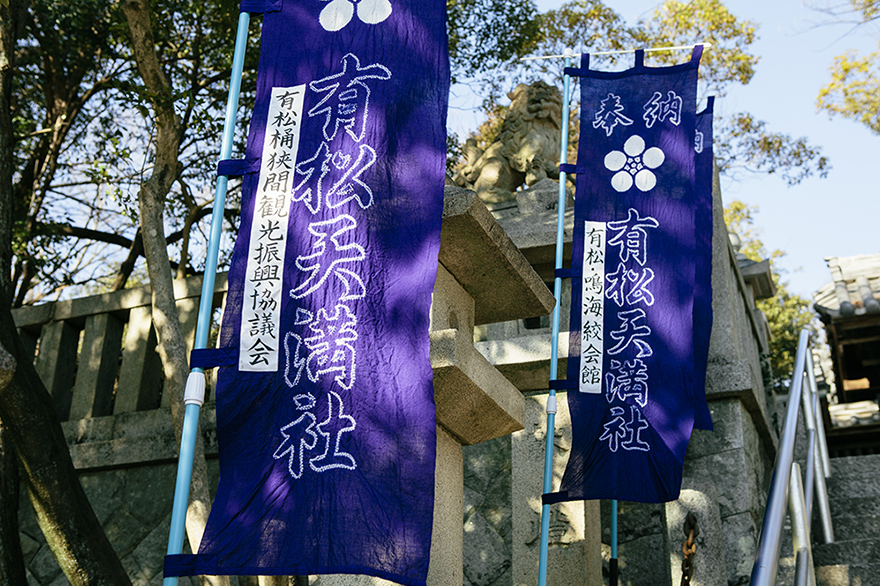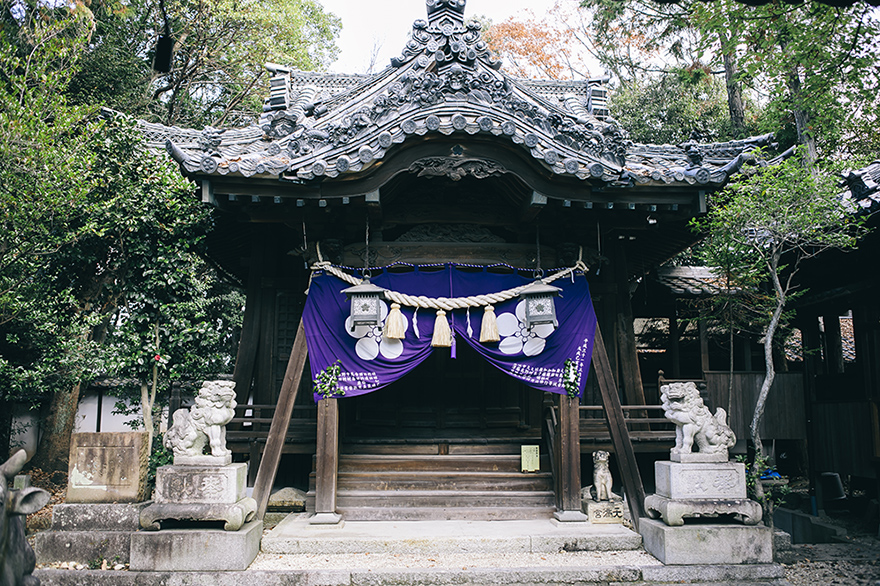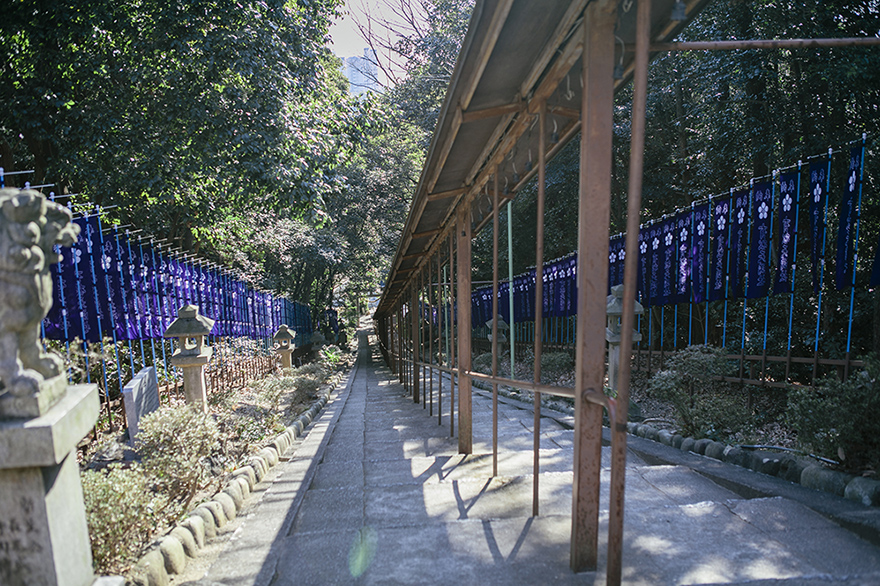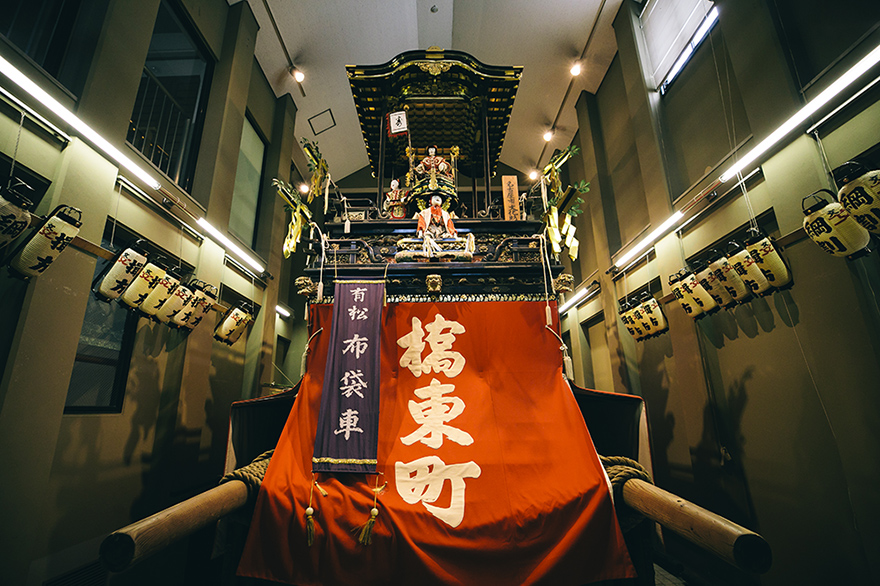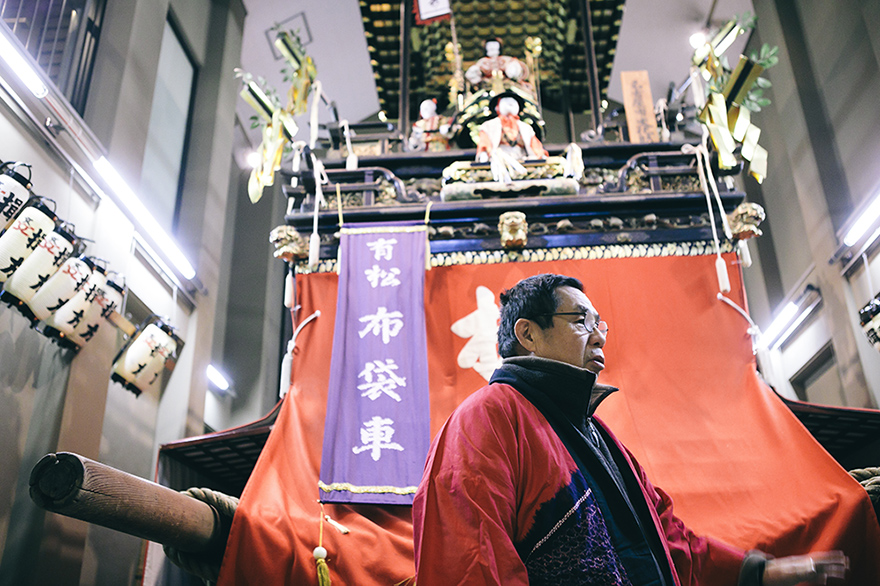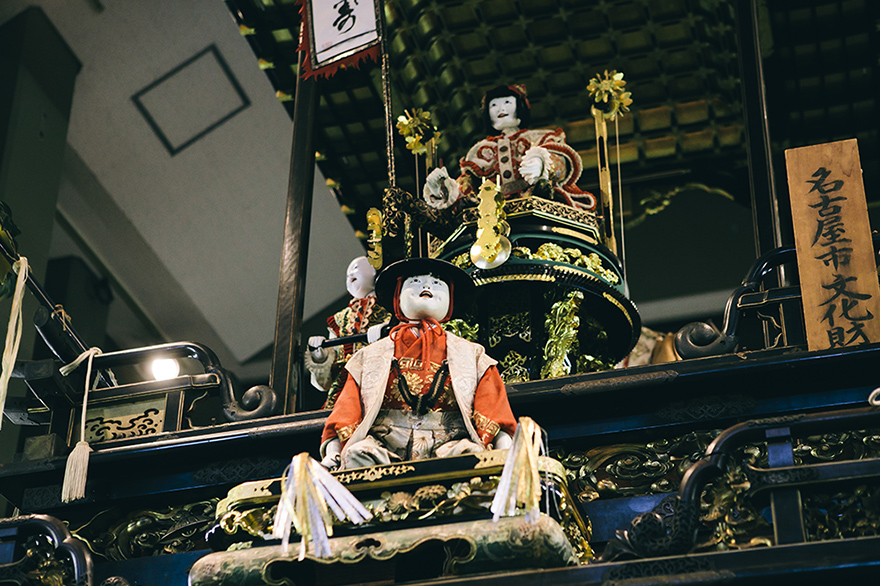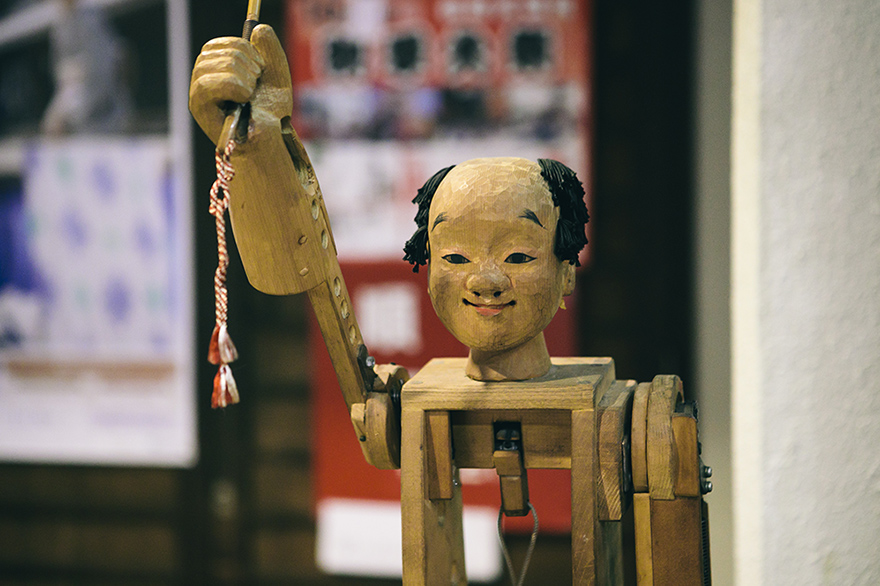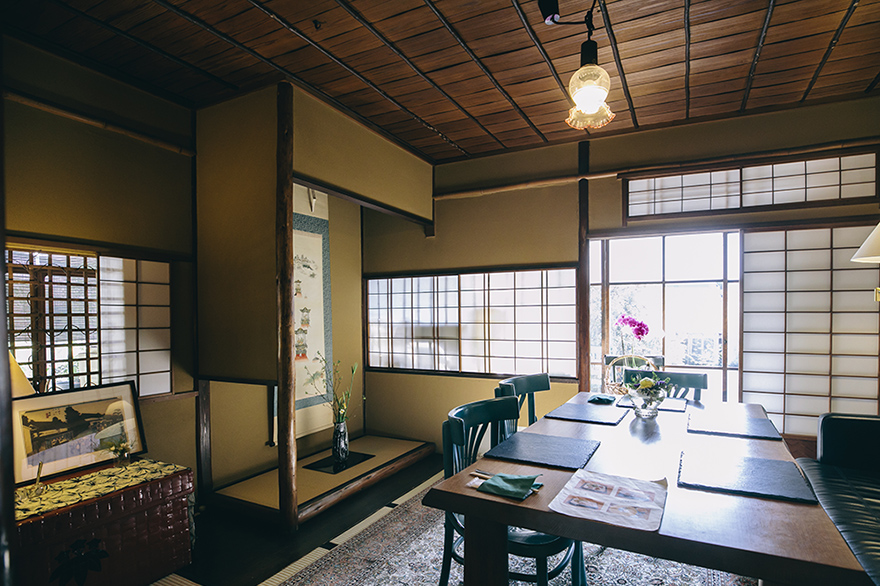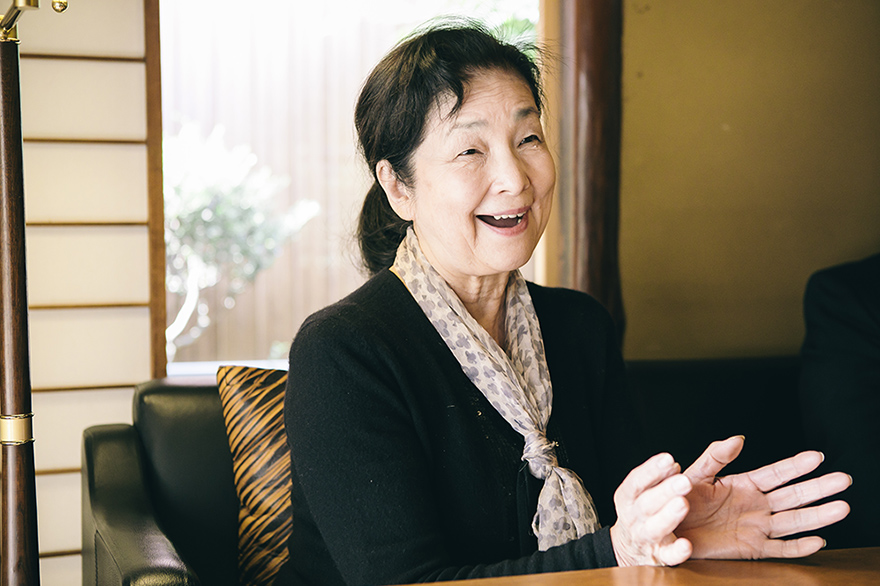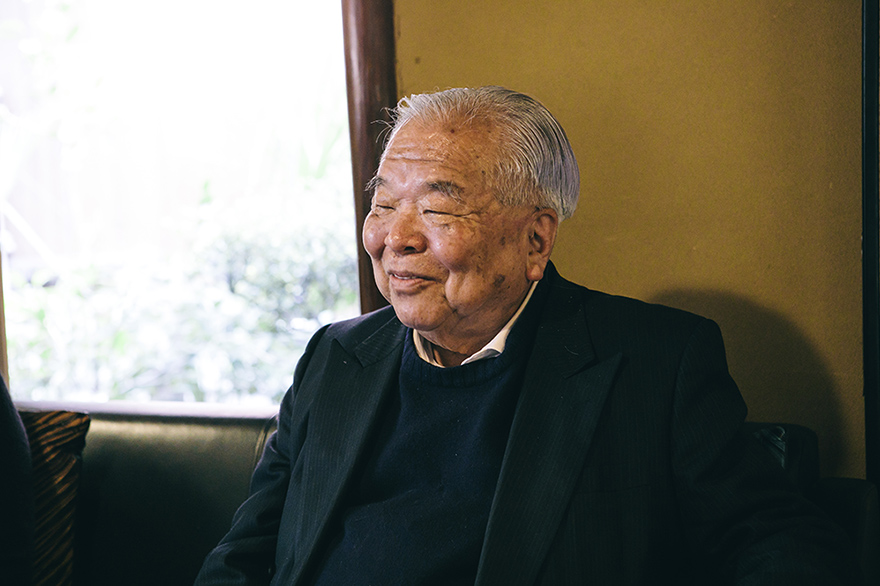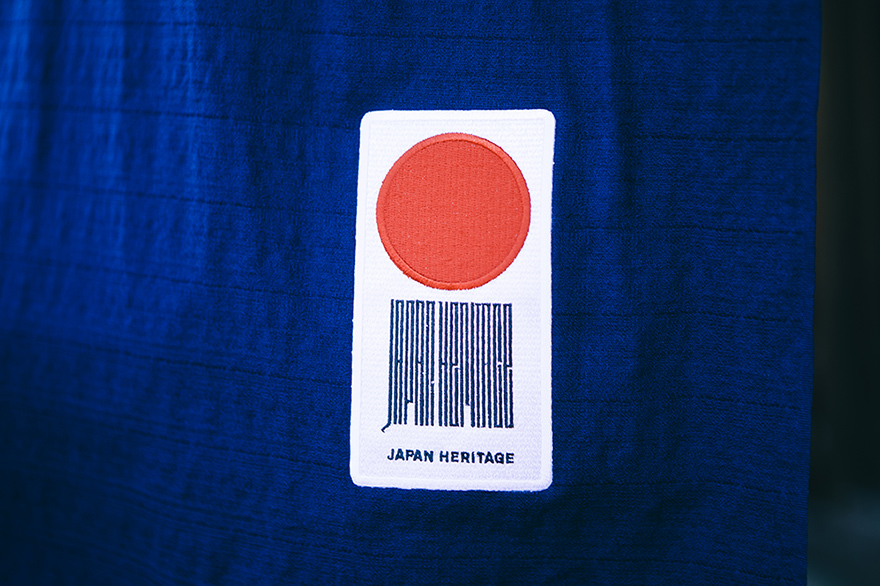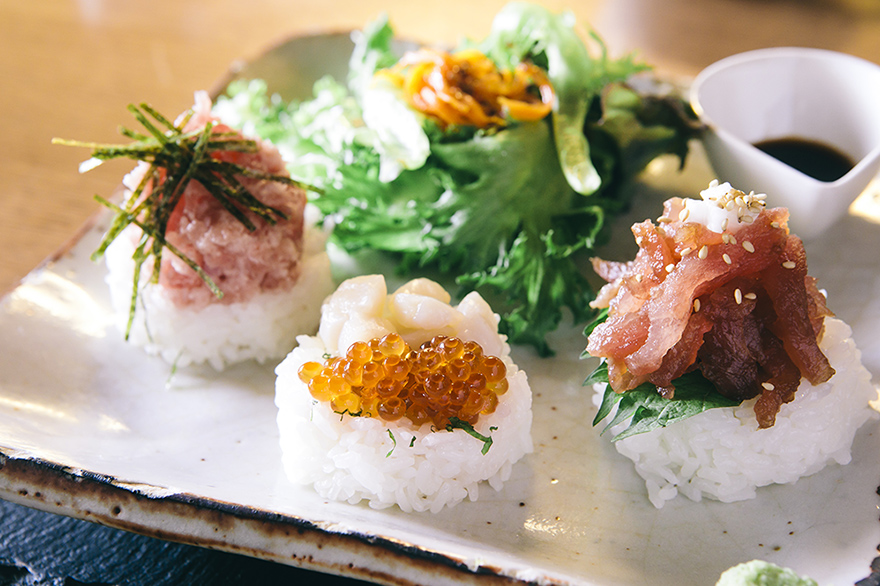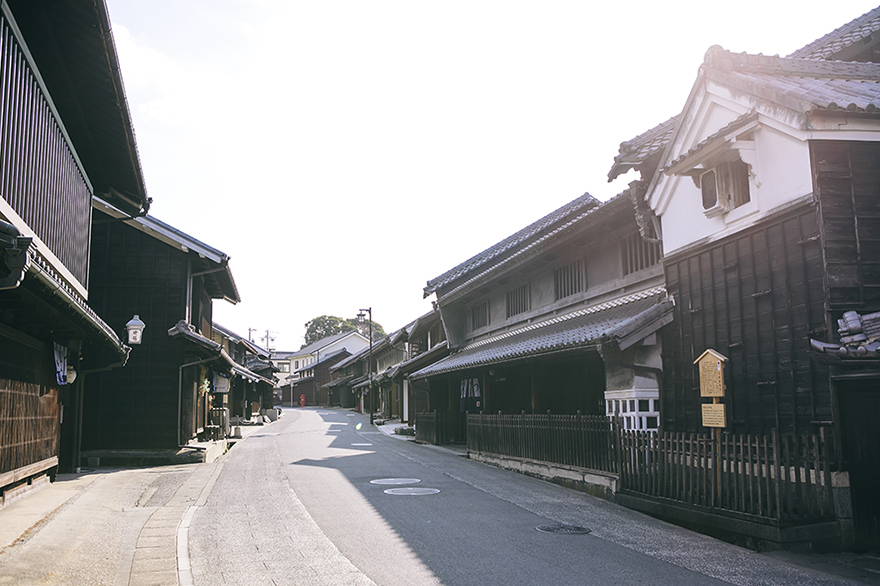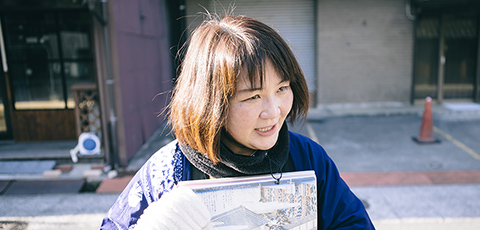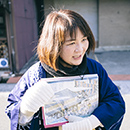Another thing that’s fun about walking around Arimatsu, aside from its tie-dyeing traditions, is seeing the historical townscape that overflows with historical atmosphere. Our tour guide this time is Mutsushika Harumi, who works as a tour guide with the Arimatsu Tour Guide Association. She is a popular person in Arimatsu, with a strong, clear voice and an endlessly bright smile that people find appealing. What Harumi likes most about the valuable buildings that line the streets here is their roofs and roof tiles. She introduced us to numerous hidden sights that we wouldn’t noticed from just wandering around, and places of interest that even non-enthusiasts can enjoy.
Valuable buildings that retain the characteristics of each era
View of the Arimatsu Dyeing Establishment Between Chiryu and Narumi on the Tokaido (by Hiroshige) and the Present Townscape
In May of 2019, Arimatsu became the first district in Nagoya to be designated a Japan Heritage site. In addition to Arimatsu’s tie-dyeing culture, which has been carefully preserved over the span of 400 years, the great value of its historical townscape, with many spots that resemble scenes from ukiyo-e woodblock prints, has been highly acclaimed.
“Now, let me start today’s walk around Arimatsu by telling you about this location here. If you stand here and look in all directions, you can see buildings from different eras all at once. Start by comparing this building with this picture!”
Standing at an intersection on the Tokaido Road, the energetic Harumi holds up a nishiki-e woodblock print by Utagawa Hiroshige called View of the Arimatsu Dyeing Establishment Between Chiryu and Narumi on the Tokaido. The building with the latticed windows in front of us has half the frontage of the one in Hiroshige’s painting, but you can still clearly make out that it’s the same building.
“This building was built in the Edo period as shown in the nishiki-e woodblock print. To the west, you can see Jugemu Tea Shop. It’s now an udon shop, but that building was built in the Meiji era. Furthermore, Yasuda Shoten, the shop just before it, is from the Taisho era. Hashizume and Company across the street is a building from the early Showa era. Each building has characteristics that are typical of its respective era.”
All of these quaint buildings have a sense of history. If you look closely, you can see how their second floors got higher with each passing era, from the Edo period to the Showa period.
“During the Edo period, processions of feudal lords would come and go along the Tokaido Road. It is said that the height of houses was limited in those days because it would not do for people to be looking down at the lords from a higher location.”
The house of the Hattori family, wealthy merchants of tie-dyed fabrics, is a stylish example of machiya (merchant’s house) architecture.
House of Hattori (Igetaya)
Walking west, we come to the House of Hattori. This tie-dyeing business was founded in 1790. The building has been designated an Aichi prefectural tangible cultural property. The spacious property includes the main house, storehouse, and parlor. You can see all the distinctive characteristics of Arimatsu machiya (merchant’s house) architecture, namely nurigome-zukuri plastered walls, mushiko-mado windows, namako walls, and renji-koshi lattices. The entrance to the property is also said to be the largest in Arimatsu.
“Look at the roof of the main house. See those two small roofs? Those are called udatsu. Udatsu were originally built to check the spread of fire — fire prevention, in other words. However, they are said to have had even greater significance as a symbol of power and wealth.”
There used to be dozens of houses in Arimatsu with udatsu, but most of them have disappeared due to fires and natural disasters. Today, only two remain: the House of Hattori and the House of Kozuka in Nishimachi.
Rebuilding after a fire using roof tiles filled with hope
Creating a fire-free town
Almost all of Arimatsu burnt to the ground in the Great Fire of 1784. That led to the replacement of thatched roofs with tile roofs. That is why so many houses have tile roofs despite the old architecture. Plaster and other fire-resistant materials were also used for walls to create a more fire-resistant town.
“The roof tiles of each house have numerous design elements related to water, such as the character for water, water splashes, water droplet patterns, and whirlpool patterns. These symbolized the people’s hopes that there would never be another fire. Now have a look at this. Do you know how these characters are pronounced?”
Harumi shows us the characters of an unfamiliar word: 懸魚.
“They’re pronounced ‘gegyo’, and the characters together mean ‘hanging fish’. A gegyo is something that attaches to a building below the ridge end tile. It is also a fish-shaped decoration that incorporates a wish for fire prevention. You often see them on shrines and temples, but in Arimatsu, the roofs of houses have them as well.”
Arimatsu’s borders determined by a river
Nakagawa Bridge – Yamayo Promenade – Komadome
As we pay close attention to Harumi’s guidance, we head further west along the Tokaido Road.
“The town of Arimatsu is divided into the Higashimachi, Nakamachi, and Nishimachi neighborhoods along the Tokaido Road. As depicted in a village map from the Tempo period, a river once flowed through nearly the center of the town, and the town of Arimatsu was formed in that area. Today, only a stone pillar called Nakagawa Bridge remains, and the river itself is now a culvert, but the river used to divide the town into the neighborhoods of Okan and Hashihigashi. Arimatsu is also distinctive for still having a lot of alleyways. This road that runs along the river is called Yamayo Promenade after Yamada Yokichiro, a tie-dyeing merchant.”
As we walk along the highway, our eyes are sometimes drawn to ring-shaped iron fittings attached to pillars underneath eaves and on pillars beside the entrances of old buildings. These are called komadome, and in the olden days, they were used to tie up the horses used by highway travelers. The ones higher up are for horses. There are also some attached in places close to the ground, and these were apparently used for tying up cows.
We want to convey to visitors the value of this town that has survived the passage of time.
Guest House MADO
Some people continue to carefully protect the value of the things in Arimatsu that are old but good, while other promising people breathe new life into the town by widely proclaiming its allure to all of Japan and to the world.
Mr. and Mrs. Oshima run an inn in a renovated 100-year-old house beside the Tokaido Road. They use lodging and food to convey the beauty of Arimatsu to visitors. The husband, Kazuhiro, and his wife, Mihoko, both used to work for an apparel manufacturer. A little over five years ago, Kazuhiro returned to his birthplace, Arimatsu, and started Guest House MADO with his wife.
“I can’t explain things as well as a tour guide (laughter), but I do talk about Arimatsu with guests who come here for lodging or a meal.”
Many of the guests who make reservations in advance to stay at the inn don’t know anything about the town of Arimatsu and come having only read information about MADO. When they actually visit the town, they feel fresh surprise at the historical townscape and the culture of tie-dyeing they find there.
“When I show them ukiyo-e woodblock prints, they are interested in the fact that the same scenes depicted in those prints still exist. I myself was born and raised in this town, but I never realized its value during my childhood. I would just think, ‘That thing is old. Wouldn’t something new be cooler?’ (laughter) It’s strange that my job is now to tell outsiders about the great things this town has. Even young people understand the charm of old things. Just sitting in the tatami room and looking out the window at the historical townscape outside causes people to say, ‘It’s nice here, isn’t it?’ Actually, I feel as though I’m the one who’s being taught by my guests.”
Arimatsu is a small town. Not many people spend a long time during their stay here, says Kazuhiro. He and Mihoko, the proprietress, have been working on numerous ideas to help guests make the most of their time here by experiencing the good things that Arimatsu has.
“During the day, you can try a tie-dyeing activity at a workshop, and then we turn the tenugui hand towel you made into a patchwork cloth overnight bag for your pajamas and towel that is ready when you check out. We were thinking of starting a service so that people could take something home as souvenirs. We wanted people to relax and enjoy their stay, so we thought it would be nice if we provided lodging services that included an activity that guests could do in the town.”
Mihoko’s thoughtful, home-cooked meals are very popular among travelers and diners, adding some extra flavor to their recollections of Arimatsu.
“When I looked into the food of the Edo period, I was impressed by how environmentally friendly it was. I also use traditional fermented foods, and I focus on serving homemade food with the intention of avoiding waste as much as possible. Because this town is dyed with centuries of ancient wisdom as symbolized by tie-dyeing, I want to be able to share things rooted in our history like that with guests.”
A wholesaler of tie-dyed products associated with the Takeda family, who were the originators of Arimatsu tie-dyeing
Takeda Kahei Shop
“The House of Takeda is kitty-corner from MADO. This is the residence of the family of Takeda Shokuro, who is said to be one of the eight people who first settled the town of Arimatsu and the originator of tie-dyeing here. You can see the character for bamboo grass (sasa) on the round tiles. The business is called ‘Sasaka’. It’s also a valuable building architecturally, having been designated a tangible cultural property by the City of Nagoya.”
Takeda Kahei Shop was built in the Edo period by a branch of the Takeda Shokuro family. The main building underwent major renovations during the Meiji and Taisho periods. The magnificent mansion with its wide frontage and depth of 80 meters attests to the scale and influence of Arimatsu’s leading tie-dyeing merchant. Saishoan, a tea ceremony room visited by 14th-generation shogun Tokugawa Iemochi of the Tokugawa shogunate, still exists, along with the storehouses, the parlor, and the udegimon gate, which was used as an entrance for loyal customers and important guests. The architectural styles of the Edo and Meiji periods have preserved the atmosphere of times past.
Gargoyle ridge end tiles and Shoki statues facing each other on rooftops
Gargoyle ridge end tiles and Shoki statues
“As you walk around the town, you will notice that there are numerous mansions with magnificent onigawara (gargoyle) ridge end tiles. However, if you live in a house across the street from those tiles, then those gargoyles are glaring at you! In the olden days, it was thought that people in houses being glared at by gargoyles would get sick, so they had the custom of placing Shoki statues on the rooftops of those houses to ward off misfortune. This custom survives to the present day in Arimatsu, and if you look carefully, you can find Shoki statues on the rooftops of various houses.”
Nishimachi’s foremost tie-dyed product wholesaler, which bustled with travelers traveling the Tokaido Road
House of Oka
As we walk further west, away from Takeda Kahei Shop, we see the townscape where the highway gently curves. Harumi takes out an ukiyo-e woodblock print and superimposes it over that view.
“This is ‘Narumi’ from a famous series of ukiyo-e woodblock prints, The Fifty-Three Stations of the Tokaido, painted by Hiroshige. Since Arimatsu was not a post station, the picture is named after Narumi, but the feel of the curving road and the features of the buildings in the picture suggest that this is the area that is actually depicted.”
The strikingly large, magnificent building that stands on a corner near the edge of Nishimachi is the House of Oka, which was depicted in a nishiki-e woodblock print by Odagiri Shunko titled Arimatsu Dyeing Establishment – Maruya Josuke Storefront. It was a wholesaler of tie-dyed products from the Edo period to the early Showa period. The main building has one of the largest frontages of all traditional buildings in Arimatsu. In the olden days, they used to open up the store facing the street and prospered by selling their wares to travelers on the road.
It has a gabled hirairi-style roof, and its walls and eaves are plastered in the nurigome-zukuri style. The windows are mushiko-mado windows with vertical lattices. It’s particularly notable that the walls, pillars, and even beams of the cauldron room are earthen-walled with a wavy pattern, which is a rare sight that can only be seen in the House of Oka today. The main building is said to have been built at the end of the Edo period, and since there have been few opportunities to renovate it, it has been carefully preserved as a valuable cultural property that retains many of the characteristic designs of Arimatsu tie-dyeing merchants. In the future, there are plans to make further improvements to the buildings so that visitors can tour the garden and storehouse. This spot is a must-see location for those who tour the townscape to learn about the history and traditions of Arimatsu.
“The place is open to the public on Saturdays and Sundays, and anyone can tour it free of charge. We tour guides take turns showing visitors around. Please stop by and ask for our assistance!”
A historic shrine that watches over the town of Arimatsu
Arimatsu Temmansha Shrine
The lanterns standing beside the Tokaido Road mark the entrance to the approach to Arimatsu Temmansha Shrine. This shrine is said to have been founded during the late Edo period when a small shrine was moved from Gionji Temple to the mountain on the north side, and a shrine hall was built. The god enshrined here is Sugawara no Michizane, the god of learning and the tutelary deity of the people of Arimatsu.
“The shrine is located all the way at the top of the small mountain in front of us, northward. The long, steep stairs can be tough to climb, but let’s give it our best shot!”
The Grand Autumn Festival takes place in the precincts of Temmansha Shrine on the first Sunday in October each year. The biggest attraction of the festival is the pulling of the floats and karakuri doll performances by festival participants dressed in elaborately designed tie-dyed costumes prepared by each neighborhood.
“The float pullers, the musicians, and the puppeteers shout ‘Wasshoi! Wasshoi!’ in time with the rhythm of the taiko drums as they come running up these stairs. Then they make three more laps around the plaza. That sounds tough, doesn’t it? But when you see it close up, it’s amazingly powerful!”
The unveiling of majestic floats at the annual Grand Autumn Festival
Arimatsu Dashi Float Museum
The floats that get revealed at the Grand Autumn Festival are stored in each of Arimatsu’s three neighborhoods: Higashimachi, Nakamachi, and Nishimachi. Right now, of those three, we’re looking at the Higashimachi float. We asked Hamajima Masatsugu, the director of the Arimatsu Dashi Float Museum, about the float.
“The Higashimachi float is called ‘Hotei-sha’. It is one of the oldest floats remaining in Nagoya. It was originally used for the Wakamiya Hachiman Shrine festival in Naka Ward, Nagoya, and we acquired it in 1891. We have records of it being used in festivals at least 340 years ago, so it was probably made even earlier than that.”
The float, which is decorated with large, gorgeous, embroidered curtains and mizuhiki curtains, carries four dolls: a writing doll, a karako doll (a doll dressed in Chinese clothing), a Hotei doll, and a zaifuri (commander) doll.
“The dolls are somewhat newer than the floats, but they are still about 230 years old. They were made by Tamaya Shobei II. These are probably the oldest karakuri dolls in Japan to bear the name ‘Tamaya’. The reason why the floats are so highly regarded is that they have remained virtually untouched since they were made. They have been repainted, and the dolls have received new costumes, but the basic structural parts are the same as when the float was made. Thanks to the tie-dyeing industry, Arimatsu was financially wealthy and was able to spend a lot of money to care for it properly. Fortunately, it was also spared from damage during the war, which is why it survives in its current shape.”
The appeal of a town that is nurtured by the love and attention of people
Show-Kuro Cafe and Takeda Kahei Shop
Takeda Kahei, the present head of the Takeda family, is a descendant of Takeda Shokuro, the originator of Arimatsu tie-dyeing. He was born and raised at Takeda Kahei Shop and is the current protector of the building and its culture. His sister, Nakamura Yoshiko, works as the director of NPO Consortium Arimatsu. They have inherited the dream of their father, who wished to preserve the historical townscape of Arimatsu, and they and their partners have focused their efforts on getting Arimatsu to be recognized as a Japan Heritage site.
Kahei says, “Our initial feeling was, ‘There’s no way we could be a Japan Heritage site!’ However, thanks to the great efforts of Hattori Yutaka and Fujieda Seiji of the Arimatsu Community Development Association, and eventually the cooperation of the City of Nagoya, we managed to obtain recognition. It was also a good thing that Arimatsu had been selected as an important preservation district for groups of traditional buildings two years earlier. Becoming a building preservation district is based mainly on an assessment of physical structures, but Japan Heritage is concerned with the nurturing of culture together with the ongoing use of those structures — in other words, it emphasizes the intangible elements. I am very pleased that both aspects of Arimatsu have received recognition.”
Yoshiko is just as pleased by that recognition, if not more so.
“The appeal of Arimatsu lies in its historical townscape, its traditional handicrafts, and its festivals. These three things are fundamental. What’s more, the most valuable thing that I think is unique to this place is that everyone in this town is sincere when they way they love Arimatsu. Both the tie-dyeing and the historical townscape have been treated with care as things that actually seem normal to us, and not special. I’m surprised that we even attract attention as a tourist destination. However, when outsiders recognized the undoubtedly wonderful value that our town possessed, our own awareness changed as well. I am overjoyed to have felt this renewed pride and to have rediscovered Arimatsu’s appeal.”
In 2017, Yoshiko renovated the Shokuro residence, which had been an annex of the House of Takeda, and she opened a cafe there. The Show-Kuro Cafe is the result of a longtime desire to provide a place where visitors to Arimatsu can relax and enjoy themselves. She serves her customers each day with vigor.
“Thanks to the cafe, I’ve been blessed to meet a variety of customers. I’m so happy for those kinds of encounters. Even a tie-dyed kimono is radiantly beautiful when someone wears one and is seen by others. Similarly, I believe that a town can only prosper if people come and appreciate it.”
The history-laden townscape and traditional techniques of Arimatsu have always been protected by the pride and passion of numerous people throughout the ages. The tour guides, who are dedicated to enhancing the town’s appeal and passing on its culture, have added color to our visit by thoughtfully showing us around the town. We recommend going for a walk around Arimatsu, where the ambiance changes with the seasons.
PROFILE
Guide:
Mutsushika Harumi
After leaving Ichinomiya and becoming an Arimatsu resident through marriage, Harumi came to be fascinated by the appeal of this town with its unique culture and history. She became a member of the tour guide association so she could share this fascination with others. Harumi has a unique way of revealing the unique story of Arimatsu, hidden away in places we might otherwise overlook, that is fun and refreshing. With 17 years of experience as a veteran tour guide she continues to make new fans of Arimatsu to this day.
This website provides information on eating out in Arimatsu.
